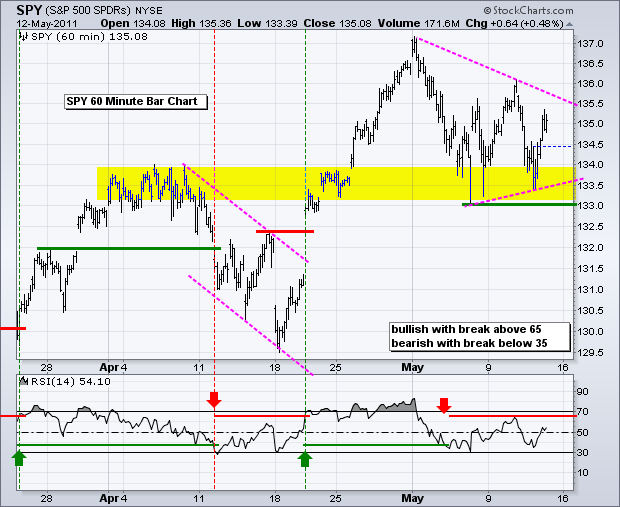There is no change on the daily chart, which remains in an uptrend overall. SPY broke a resistance zone and this zone turned into a short-term support zone. So far, the support zone is holding as the ETF bounced off the 133-134 area twice in the last two weeks. Clearly, 133 is an important short-term support level. This level is also confirmed by the trendline extending up from the mid May low. A break below 133 would be short-term bearish, but this would not do enough technical damage to affect the medium-term uptrend. I am still marking medium-term support at the April low. As long as the medium-term trend remain up, short-term downtrends are viewed as corrections running against the bigger trend.

Some traders are no doubt looking for an edge while prices trade within this range. Even though the medium-term trend is up, I am seeing signs of weakness in short-term momentum. RSI on the 60-minute chart broke down in early May and failed at bear-zone resistance this week. StochRSI on the daily chart broke down with Wednesday's sharp decline. As noted yesterday, Tuesday's decline was just a little too deep for a mere pullback. Bearish momentum and Tuesday's sharp decline, suggest that SPY will break support at 133 and correct further.
Key Economic Reports/Events:
Fri - May 13 - 08:30 - Consumer Price Index (CPI)
Fri - May 13 - 09:55 - Michigan Sentiment
Charts of Interest: Tuesday and Thursday in separate post.
***********************************************
This commentary and charts-of-interest are designed to stimulate thinking. This analysis is not a recommendation to buy, sell, hold or sell short any security (stock ETF or otherwise). We all need to think for ourselves when it comes to trading our own accounts. First, it is the only way to really learn. Second, we are the only ones responsible for our decisions. Think of these charts as food for further analysis. Before making a trade, it is important to have a plan. Plan the trade and trade the plan. Among other things, this includes setting a trigger level, a target area and a stop-loss level. It is also important to plan for three possible price movements: advance, decline or sideways. Have a plan for all three scenarios BEFORE making the trade. Consider possible holding times. And finally, look at overall market conditions and sector/industry performance.







